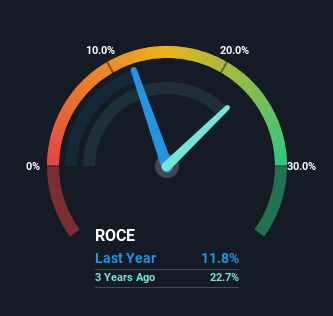- Hong Kong
- /
- Renewable Energy
- /
- SEHK:90
Puxing Energy (HKG:90) Is Looking To Continue Growing Its Returns On Capital
If we want to find a stock that could multiply over the long term, what are the underlying trends we should look for? Amongst other things, we'll want to see two things; firstly, a growing return on capital employed (ROCE) and secondly, an expansion in the company's amount of capital employed. This shows us that it's a compounding machine, able to continually reinvest its earnings back into the business and generate higher returns. So when we looked at Puxing Energy (HKG:90) and its trend of ROCE, we really liked what we saw.
Understanding Return On Capital Employed (ROCE)
For those who don't know, ROCE is a measure of a company's yearly pre-tax profit (its return), relative to the capital employed in the business. Analysts use this formula to calculate it for Puxing Energy:
Return on Capital Employed = Earnings Before Interest and Tax (EBIT) ÷ (Total Assets - Current Liabilities)
0.12 = CN¥119m ÷ (CN¥1.8b - CN¥784m) (Based on the trailing twelve months to June 2023).
So, Puxing Energy has an ROCE of 12%. In absolute terms, that's a satisfactory return, but compared to the Renewable Energy industry average of 6.8% it's much better.
See our latest analysis for Puxing Energy

Historical performance is a great place to start when researching a stock so above you can see the gauge for Puxing Energy's ROCE against it's prior returns. If you'd like to look at how Puxing Energy has performed in the past in other metrics, you can view this free graph of Puxing Energy's past earnings, revenue and cash flow.
What The Trend Of ROCE Can Tell Us
Puxing Energy is showing promise given that its ROCE is trending up and to the right. Looking at the data, we can see that even though capital employed in the business has remained relatively flat, the ROCE generated has risen by 26% over the last five years. Basically the business is generating higher returns from the same amount of capital and that is proof that there are improvements in the company's efficiencies. On that front, things are looking good so it's worth exploring what management has said about growth plans going forward.
For the record though, there was a noticeable increase in the company's current liabilities over the period, so we would attribute some of the ROCE growth to that. Essentially the business now has suppliers or short-term creditors funding about 44% of its operations, which isn't ideal. Given it's pretty high ratio, we'd remind investors that having current liabilities at those levels can bring about some risks in certain businesses.
The Bottom Line On Puxing Energy's ROCE
In summary, we're delighted to see that Puxing Energy has been able to increase efficiencies and earn higher rates of return on the same amount of capital. Given the stock has declined 29% in the last five years, this could be a good investment if the valuation and other metrics are also appealing. That being the case, research into the company's current valuation metrics and future prospects seems fitting.
Puxing Energy does have some risks, we noticed 2 warning signs (and 1 which is potentially serious) we think you should know about.
While Puxing Energy may not currently earn the highest returns, we've compiled a list of companies that currently earn more than 25% return on equity. Check out this free list here.
New: Manage All Your Stock Portfolios in One Place
We've created the ultimate portfolio companion for stock investors, and it's free.
• Connect an unlimited number of Portfolios and see your total in one currency
• Be alerted to new Warning Signs or Risks via email or mobile
• Track the Fair Value of your stocks
Have feedback on this article? Concerned about the content? Get in touch with us directly. Alternatively, email editorial-team (at) simplywallst.com.
This article by Simply Wall St is general in nature. We provide commentary based on historical data and analyst forecasts only using an unbiased methodology and our articles are not intended to be financial advice. It does not constitute a recommendation to buy or sell any stock, and does not take account of your objectives, or your financial situation. We aim to bring you long-term focused analysis driven by fundamental data. Note that our analysis may not factor in the latest price-sensitive company announcements or qualitative material. Simply Wall St has no position in any stocks mentioned.
About SEHK:90
Puxing Energy
An investment holding company, develops, operates, and manages natural gas-fired power plants in the People’s Republic of China.
Flawless balance sheet with slight risk.
Market Insights
Community Narratives




